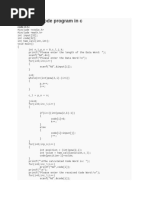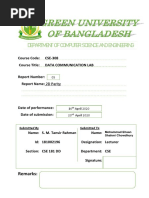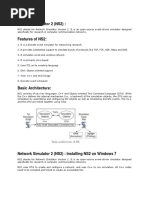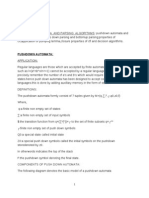Hamming Code
Hamming Code
Uploaded by
Kiran KumarCopyright:
Available Formats
Hamming Code
Hamming Code
Uploaded by
Kiran KumarOriginal Description:
Copyright
Available Formats
Share this document
Did you find this document useful?
Is this content inappropriate?
Copyright:
Available Formats
Hamming Code
Hamming Code
Uploaded by
Kiran KumarCopyright:
Available Formats
2.
Implement the Data Link layer error detection and correction techniques using
Hamming Code.
Procedure:
Hamming code is a popular error detection and error correction method in data communication.
Hamming code can only detect 2 bit error and correct a single bit error which means it is unable to
correct burst errors if may occur while transmission of data.
Hamming code uses redundant bits (extra bits) which are calculated according to the below
formula:-
2r ≥ m+r+1
Where r is the number of redundant bits required and m is the number of data bits.
R is calculated by putting r = 1, 2, 3 … until the above equation becomes true.
R1 bit is appended at position 20
R2 bit is appended at position 21
R3 bit is appended at position 22 and so on.
These redundant bits are then added to the original data for the calculation of error at receiver’s
end.
At receiver’s end with the help of even parity (generally) the erroneous bit position is identified
and since data is in binary we take complement of the erroneous bit position to correct received
data.
Respective index parity is calculated for r1, r2, r3, r4 and so on.
Advantages of Hamming Code
1. Easy to encode and decode data at both sender and receiver end.
2. Easy to implement.
Disadvantages of Hamming Code
1. Cannot correct burst errors.
2. Redundant bits are also sent with the data therefore it requires more bandwidth to send
the data.
#include<stdio.h>
#include<stdlib.h>
#include<conio.h>
char data[5];
int encoded[8],edata[7],syndrome[5];
int hmatrix[3][7]={
1,0,0,0,1,1,1,
0,1,0,1,0,1,1,
0,0,1,1,1,0,1,
};
char gmatrix[4][8]={"0111000","1010100","1100010","1110001"};
int main()
{
int i,j;
clrscr();
printf("\n Hamming code-----Encoding");
printf("\n Enter 4 bit data:");
scanf("%s",data);
printf("\n Generator matrix:");
for(i=0;i<4;i++)
printf("\n%s",gmatrix[i]);
printf("\n Encoded data:");
for(i=0;i<7;i++)
{
for(j=0;j<4;j++)
encoded[i]+=((data[j]-'0')*(gmatrix[j][i]-'0'));
encoded[i]=encoded[i]%2;
printf("%d",encoded[i]);
}
printf("\n Hamming code---Decoding");
printf("\n Enter encoded bits as received:");
for(i=0;i<7;i++)
scanf("%d",&edata[i]);
for(i=0;i<3;i++)
{
for(j=0;j<7;j++)
syndrome[i]+=(edata[j]*hmatrix[i][j]);
syndrome[i]=syndrome[i]%2;
printf("syndrome:%d\t",syndrome[i]);
}
for(j=0;j<7;j++)
if((syndrome[0]==hmatrix[0][j] && (syndrome[1]==hmatrix[1][j] &&
(syndrome[2]==hmatrix[2][j]))))
break;
if(j==7)
printf("\n error free");
else
{
printf("\n error received at bit number %d of data",j+1);
edata[j]=!edata[j];
printf("\n correct data should be:");
for(i=0;i<7;i++)
printf("%d",edata[i]);
}
getch();
return 0;
}
output:
Hamming code-----Encoding
Enter 4 bit data:1011
Generator matrix:
0111000
1010100
1100010
1110001
Encoded data:0101011
Hamming code---Decoding
Enter encoded bits as received:0 1 0 1 0 1 1
syndrome:0 syndrome:0 syndrome:0
error free
Hamming code-----Encoding
Enter 4 bit data:1011
Generator matrix:
0111000
1010100
1100010
1110001
Encoded data:0101011
Hamming code---Decoding
Enter encoded bits as received:0 1 0 1 1 1 1
syndrome:1 syndrome:0 syndrome:1
error received at bit number 5 of data
correct data should be:0101011
You might also like
- Dccn lab 2024 (1)Document63 pagesDccn lab 2024 (1)ShaikNo ratings yet
- CN MANUAL NEW JAVA - Docx SreeDocument82 pagesCN MANUAL NEW JAVA - Docx SreeRaghul MNo ratings yet
- CN Lab Manual SCCEDocument72 pagesCN Lab Manual SCCEvivekvivvi70No ratings yet
- 22bce2414 VL2024250104743 Ast02Document16 pages22bce2414 VL2024250104743 Ast02MR TECH BEAST YTNo ratings yet
- 22BDS0229 Da 2 CNDocument15 pages22BDS0229 Da 2 CNMR TECH BEAST YTNo ratings yet
- Record DCN (S)Document18 pagesRecord DCN (S)thaangu2003No ratings yet
- CN Lab ManualDocument101 pagesCN Lab Manualtatova7977No ratings yet
- 22bce2414 VL2024250104743 Ast02Document15 pages22bce2414 VL2024250104743 Ast02MR TECH BEAST YTNo ratings yet
- Function Hamming (1)Document2 pagesFunction Hamming (1)pushkarshingote599No ratings yet
- Automata Fi QuestionsDocument29 pagesAutomata Fi QuestionsGAMING FREAKSNo ratings yet
- CN Exp3Document9 pagesCN Exp3bhavik shahNo ratings yet
- Aim: Program:: Implement The Data Link Layer Framing Methods Such As Character CountDocument21 pagesAim: Program:: Implement The Data Link Layer Framing Methods Such As Character CountUmme Aaiman100% (1)
- CN Lab - 4Document9 pagesCN Lab - 4Venkata Prasad SNo ratings yet
- Program 1. WAP To Implement Bit Stuffing (Sender End)Document16 pagesProgram 1. WAP To Implement Bit Stuffing (Sender End)Rahul SinghNo ratings yet
- PPS All Units 2 MarksQuestions With AnswersDocument33 pagesPPS All Units 2 MarksQuestions With AnswersHARIKRISHNA SATVIKNo ratings yet
- CN and WP Lab ManualDocument101 pagesCN and WP Lab ManualBam NoiceNo ratings yet
- CN PracticalDocument13 pagesCN PracticalManash Ranjan SahuNo ratings yet
- Practical CNDocument14 pagesPractical CNmehtanish.20.ceNo ratings yet
- Assignment 2Document6 pagesAssignment 2shubos467No ratings yet
- NS lab FinalDocument369 pagesNS lab FinalBuvan SivaNo ratings yet
- EC3401-NETWORKS AND SECURITY - 1932694304-EC 3401 N&S Lab Manual - 2021 REGDocument29 pagesEC3401-NETWORKS AND SECURITY - 1932694304-EC 3401 N&S Lab Manual - 2021 REGnandhunadhini596No ratings yet
- CN Lab Manual (1-9)Document31 pagesCN Lab Manual (1-9)dhosheka123No ratings yet
- CNP LAB ProgramsDocument36 pagesCNP LAB ProgramsMuhammed AkramNo ratings yet
- CSE 1004: Network and Communication (L23+L24) Assessment - 2Document20 pagesCSE 1004: Network and Communication (L23+L24) Assessment - 2Majety S LskshmiNo ratings yet
- NetworkDocument67 pagesNetworkdkdeva57No ratings yet
- CN Lab ManualDocument109 pagesCN Lab Manualtixat43536No ratings yet
- 22MIC0044DNCDocument8 pages22MIC0044DNCachyutshivam1762002No ratings yet
- CN - PART BDocument17 pagesCN - PART Bkushkruthik555No ratings yet
- AzdocumentsDocument23 pagesAzdocumentsrudrarudraharaNo ratings yet
- 21bce0427 VL2023240101150 Ast02Document17 pages21bce0427 VL2023240101150 Ast02Chethan .N.VNo ratings yet
- Lab2 CNDocument8 pagesLab2 CNDebu SinghNo ratings yet
- Green University of BangladeshDocument5 pagesGreen University of BangladeshAbu TalhaNo ratings yet
- CRC 2Document2 pagesCRC 2bobyhprasadNo ratings yet
- cts_debugging_questionDocument14 pagescts_debugging_questionArputharaj JohnsonNo ratings yet
- DebuggathonDocument21 pagesDebuggathonKnightdale RauschenbergNo ratings yet
- Week 3 Coding Assignment Name: Priyanka Indra Roll No.: 84 Dept: CSE1 Sem: 6Document10 pagesWeek 3 Coding Assignment Name: Priyanka Indra Roll No.: 84 Dept: CSE1 Sem: 6Priyanka IndraNo ratings yet
- C Language and DS MainDocument62 pagesC Language and DS MainYadamreddi Sankar KumarNo ratings yet
- Experiment 1:: Write Program To Implement Data Link Layer Stuffing MethodDocument29 pagesExperiment 1:: Write Program To Implement Data Link Layer Stuffing MethodRonit KatariaNo ratings yet
- Computer Networks Record: PojitDocument10 pagesComputer Networks Record: Pojitpoojitha ManchikalapatiNo ratings yet
- Extra Practical 1Document9 pagesExtra Practical 1hastipanseriya.co22d2No ratings yet
- Practical No: Write A Program in C To Implement VRCDocument29 pagesPractical No: Write A Program in C To Implement VRCHitessh SharmaNo ratings yet
- EC8563 Comm Networks Lab ManualDocument56 pagesEC8563 Comm Networks Lab ManualSuc RNo ratings yet
- Lab Program 4Document4 pagesLab Program 4sowjanya.kNo ratings yet
- Ex - No 10Document6 pagesEx - No 10rmsnekaas786No ratings yet
- CN 4Document9 pagesCN 41032221789No ratings yet
- Quiz 1Document3 pagesQuiz 1Viraj BhosaleNo ratings yet
- Quiz 1Document3 pagesQuiz 1Viraj BhosaleNo ratings yet
- Quiz 12Document3 pagesQuiz 12Viraj BhosaleNo ratings yet
- 4 To 13 CNDocument33 pages4 To 13 CNRitesh KolateNo ratings yet
- Cse308-Lab-Report-5 2D ParityDocument6 pagesCse308-Lab-Report-5 2D ParityAbu TalhaNo ratings yet
- CN LABDocument20 pagesCN LABmadugulaprasanna04No ratings yet
- 22BCE3591 Assessment2Document8 pages22BCE3591 Assessment2Dhruv JadavNo ratings yet
- CNlab MergedDocument19 pagesCNlab Mergedzumbazumzum47No ratings yet
- HammingDocument4 pagesHammingSHREYA BHUVADNo ratings yet
- C Sem ProgramsDocument15 pagesC Sem ProgramstsravyasriNo ratings yet
- CNLab ManualDocument39 pagesCNLab Manualkakumanuanitha0308No ratings yet
- 2.1. Introduction To RecursionDocument15 pages2.1. Introduction To RecursionKiran KumarNo ratings yet
- 6.1. Introduction To GraphsDocument28 pages6.1. Introduction To GraphsKiran KumarNo ratings yet
- Binary TreesDocument52 pagesBinary TreesKiran KumarNo ratings yet
- The Data Link Layer 1. Data Link Layer Design IssuesDocument4 pagesThe Data Link Layer 1. Data Link Layer Design IssuesKiran KumarNo ratings yet
- 6.5.1 Internal Quality Assurance Cell (IQAC) Has Contributed Significantly For Institutionalizing The Quality Assurance Strategies and ProcessesDocument5 pages6.5.1 Internal Quality Assurance Cell (IQAC) Has Contributed Significantly For Institutionalizing The Quality Assurance Strategies and ProcessesKiran KumarNo ratings yet
- Network Simulator 2Document5 pagesNetwork Simulator 2Kiran KumarNo ratings yet
- C Program To Simulate ARPDocument3 pagesC Program To Simulate ARPKiran KumarNo ratings yet
- Network Portion in The Top Bits and A Host Portion in The Bottom Bits. The NetworkDocument4 pagesNetwork Portion in The Top Bits and A Host Portion in The Bottom Bits. The NetworkKiran KumarNo ratings yet
- Cyclic Redundancy CheckDocument10 pagesCyclic Redundancy CheckKiran KumarNo ratings yet
- The Network LayerDocument3 pagesThe Network LayerKiran KumarNo ratings yet
- ARP and RARP in CDocument2 pagesARP and RARP in CKiran KumarNo ratings yet
- DBMS Lab ExcercicesDocument2 pagesDBMS Lab ExcercicesKiran KumarNo ratings yet
- Dbms NotesDocument45 pagesDbms NotesKiran KumarNo ratings yet
- T, Eft: T (N) - (2T (N - 1, If N 0 1, OtherwiseDocument2 pagesT, Eft: T (N) - (2T (N - 1, If N 0 1, OtherwiseTS OrigamiNo ratings yet
- Informed Search Algorithms: UNIT-2Document35 pagesInformed Search Algorithms: UNIT-2Tariq IqbalNo ratings yet
- CS5371 Theory of Computation: Lecture 4: Automata Theory II (DFA NFA, Regular Language)Document27 pagesCS5371 Theory of Computation: Lecture 4: Automata Theory II (DFA NFA, Regular Language)Kamal WaliaNo ratings yet
- AtcDocument39 pagesAtcSAWAN J KOTIANNo ratings yet
- 2019 WMI Prelim G08 Paper ADocument4 pages2019 WMI Prelim G08 Paper AMicin AnandiNo ratings yet
- Chomsky Normal FormDocument14 pagesChomsky Normal Formabida rasoolNo ratings yet
- FinalDocument2 pagesFinalTolichoNo ratings yet
- Analysis of Clocked Sequential Circuits and State Table and State Diagrams and Design ProcedureDocument30 pagesAnalysis of Clocked Sequential Circuits and State Table and State Diagrams and Design Procedurechanikya1No ratings yet
- Werra, 1985Document12 pagesWerra, 1985Gürkan ÖzbilNo ratings yet
- Ivy For Grasshopper Manual: 1. Meshgraph CreationDocument21 pagesIvy For Grasshopper Manual: 1. Meshgraph CreationAravind AkashNo ratings yet
- SYDSc SEM III (OCT 2023)Document8 pagesSYDSc SEM III (OCT 2023)dheerajv5610No ratings yet
- Information Retrieval: Assignment 1: Problem 1Document2 pagesInformation Retrieval: Assignment 1: Problem 1jainam dudeNo ratings yet
- On Signal Flow Graph Signal Flow GraphDocument20 pagesOn Signal Flow Graph Signal Flow Graphrub786No ratings yet
- Lecture 52Document11 pagesLecture 52vivek singhNo ratings yet
- QueuesDocument52 pagesQueuesdhanushsaikodeNo ratings yet
- Names, Bindings and Scopes: CSE 325/CSE 425: Concepts of Programming LanguageDocument41 pagesNames, Bindings and Scopes: CSE 325/CSE 425: Concepts of Programming LanguageShinthi TasnimNo ratings yet
- Rohini 78402595145Document7 pagesRohini 78402595145Christian QuayeNo ratings yet
- Ict1402 1Document19 pagesIct1402 1madawadilshan2018No ratings yet
- Program: 8. Find A Subset of A Given Set S (SL, s2,....., SN) of N Positive Integers Whose Sum Is Equal To A GivenDocument2 pagesProgram: 8. Find A Subset of A Given Set S (SL, s2,....., SN) of N Positive Integers Whose Sum Is Equal To A GivenPrashanth KumarNo ratings yet
- PRAM ModelsDocument6 pagesPRAM ModelsjazzNo ratings yet
- Unit-3 Alc NotesDocument31 pagesUnit-3 Alc NotesKo VartthanNo ratings yet
- Quantum Machine Learning An IntroDocument4 pagesQuantum Machine Learning An IntroBilal HaiderNo ratings yet
- Harjot 8 - 18Document12 pagesHarjot 8 - 18baadshahyashNo ratings yet
- Decision TreeDocument44 pagesDecision TreeAryan Akshay VerduNo ratings yet
- AI SketcherDocument14 pagesAI SketcherAnonymous lPecwQViNo ratings yet
- Performance Task E-PortfolioDocument2 pagesPerformance Task E-Portfolioapi-482110307No ratings yet
- DM PresentationDocument9 pagesDM PresentationameyaNo ratings yet
- Unit 1 Introduction, Basic ConceptsDocument22 pagesUnit 1 Introduction, Basic ConceptsLavanya JNo ratings yet
- Automata Theory and Computability: Model Question Paper-1 With Effect From 2019-20 (CBCS Scheme)Document4 pagesAutomata Theory and Computability: Model Question Paper-1 With Effect From 2019-20 (CBCS Scheme)Sushmitha AcharyaNo ratings yet
- Arman Khan - Ai Practical JournalDocument33 pagesArman Khan - Ai Practical Journalkhan ArmanNo ratings yet






































































































